Research on the Ecological Innovation Efficiency of the Zhongyuan Urban Agglomeration: Measurement, Evaluation and Optimization
Abstract
:1. Introduction
1.1. Background
1.2. The Concept of Ecological Innovation Efficiency
1.3. The Measurement and Evaluation of Ecological Innovation Efficiency
2. Materials and Methods
2.1. An Ecological Innovation Efficiency Evaluation Index System for Urban Agglomerations
2.2. Methodology
2.2.1. Super-Efficiency SBM-DEA Model
2.2.2. Entropy-Weight TOPSIS Model
- (a)
- Normalization of indicators
- (b)
- Calculation of the indicator weight
- (c)
- TOPSIS method
2.3. Data Source
3. Results
3.1. The Measurement of the Ecological Innovation Efficiency from 2006–2020
3.2. The Redundancy Analysis of the Ecological Innovation Inputs-Outputs
3.3. Evolution Analysis of Innovation Performance from Temporal Perspective
3.4. Evolution Analysis of Ecological Innovation Performance from Spatial Perspective
4. Discussion
5. Conclusions
- (1)
- Overall, the ecological innovation ability of the Zhongyuan urban agglomeration is inadequate, and the ecological innovation efficiency is relatively low. The ecological innovation performance of each city is substantially lower than that of Zhengzhou; the linkage and radiation effect of urban agglomeration innovation-driven development is not effectively reflected, and relevant national policies such as National Innovation Demonstration Zones in Zhengzhou, Luoyang and Xinxiang have not been effectively implemented.
- (2)
- From the temporal perspective, the temporal evolution of the Zhongyuan urban agglomeration shows a less obvious U-shaped trend. Although the innovation output benefits of the core development region (including 14 cities) are significantly better than the innovation output benefits of the co-development region (including 16 cities), it should be noted that this innovation benefit gap has been decreasing from 2018, which corresponds to the average performance level of the ecological innovation transformation efficiency of these the two regions, as the average ecological innovation transformation efficiency level of the co-development region exceeds the average efficiency value of the core development region. Otherwise, influenced by many factors, such as government investment, environmental regulation policies, and innovation-driven development policies, the transformation efficiency of ecological innovation in the Zhongyuan urban agglomeration shows a dynamic development trend.
- (3)
- From the spatial perspective, there are eight cities at the “high output and high efficiency”, three cities at the “low output and high efficiency” level, 19 cities at the “low output and low efficiency” level and no city at the “high output and low efficiency” level. In general, more than half of the cities are at a low level, and this indicates the urban agglomeration needs to further coordinate the sharing of ecological innovation resources, increase the investment of innovation resources, strengthen the control of undesirable outputs through various policies and regulations, increase the output of ecological innovation, improve the efficiency of ecological innovation transformation, and strive to achieve an effective balance between innovative resources, ecological environment protection and energy conservation and utilization. Furthermore, from the perspective of spatial distribution, the ecological innovation performance of most cities in the north is better than that in the south, which can be attributed to the northern cities having a good industrial foundation and a substantial innovation resource endowment. In contrast, the southern cities are based on agricultural development and lack a foundation for ecological innovation and development. In the future, we hope to achieve multi-core development in the urban agglomeration by constructing the southern sub-central city of Nanyang.
- (4)
- Through the correlation analysis between the inputs and outputs of ecological innovation, it can be seen that the optimization path to improve the ecological innovation efficiency mainly includes increasing the input of innovation manpower and capital while controlling the energy consumption, so as to increase the desirable output of ecological innovation and control the undesirable output. Furthermore, cities and regions should try their best to increase the total volume of contract turnover in the technology market and increase the number of green patents authorized, and meanwhile further strengthen the control of air pollution to reduce the PM2.5 density and the total emissions of CO2.
- (1)
- Taking the opportunity of building Nanyang as the sub-central city, the relevant sectors should accelerate the construction of the efficient ecological economy demonstration area in the south of Henan province. In the next stage, they should strengthen the exchange of resources and talents in southern Henan by constructing the Nanyang–Xinyang–Hefei high-speed railway. The above measures will change the situation of ecological innovation efficiency being more robust in the north and weaker in the south.
- (2)
- Based on the low level of ecological innovation performance in Kaifeng, they should further strengthen the integration of Zhengzhou and Kaifeng, promote deep and practical integration, and incorporate the innovative development of Kaifeng into the development process of modern metropolitan areas, coordinate the innovative resources of university parks in the east of Zhengzhou and the west of Kaifeng, and build the “mass entrepreneurship and innovation” corridor between Zhengzhou and Kaifeng.
- (3)
- Under the circumstance of the development planning of the Zhongyuan urban agglomeration, the Zhengzhou metropolitan area (including Zhengzhou, Kaifeng, Xinxiang, Jiaozuo and Xuchang) is the development core region of the Zhongyuan urban agglomeration; the western area (including Yuncheng and Sanmenxia) is positioned as the demonstration area of transformation and innovation development; the northern area (including Changzhi, Anyang, Puyang, Handan, Xingtai and Liaocheng) is positioned as the demonstration area of cross-regional and coordinated development; the southern area (including Nanyang, Zhumadian and Xinyang) is positioned as the demonstration area of efficient ecological economy, and the eastern area (including Heze, Huaibei, Suzhou, Bengbu, and Fuyang) is positioned as the demonstration area for undertaking the industrial transfer. Each demonstration zone should bring into full play its primary functions according to the spatial layout and functional positioning of the urban agglomeration, deepen the sharing of education, science and technology, culture, ecology, and other resources, and form an ecological innovation linkage radiation effect around the core development zone.
Author Contributions
Funding
Institutional Review Board Statement
Informed Consent Statement
Data Availability Statement
Acknowledgments
Conflicts of Interest
References
- Liu, L.; Yang, Y.; Liu, S.; Gong, X.; Zhao, Y.; Jin, R.; Duan, H.; Jiang, P. A comparative study of green growth efficiency in Yangtze River Economic Belt and Yellow River Basin between 2010 and 2020. Ecol. Indic. 2023, 150, 110214. [Google Scholar] [CrossRef]
- Yang, Y.; Chen, L.; Su, Z.; Wang, W.; Wang, Y.; Luo, X. Study on Spatiotemporal Features and Factors Influencing the Urban Green Total Factor Productivity in the Yellow River Basin under the Constraint of Pollution Reduction and Carbon Reduction. Processes 2023, 11, 730. [Google Scholar] [CrossRef]
- The General Office of the Communist Party of China Central Committee; The General Office of the State Council. The Guiding Opinions on Promoting High Quality Development of Central China in the New Era. 2021. Available online: https://www.gov.cn/zhengce/2021-07/22/content_5626642.htm (accessed on 21 July 2021).
- National Development and Reform Commission. The Development Plan for Zhongyuan Urban Agglomeration. 2016. Available online: https://www.gov.cn/xinwen/2017-01/05/5156816/files/4e3c18bb7f2d4712b7264f379e7cb416.pdf (accessed on 29 December 2016).
- Wang, K.; Zhang, F.; Xu, R.; Miao, Z.; Cheng, Y.; Sun, H. Spatiotemporal pattern evolution and influencing factors of green innovation efficiency: A China’s city level analysis. Ecol. Indic. 2023, 146, 109901. [Google Scholar] [CrossRef]
- Yu, Y.; Xu, Z.; Shen, P.; Zhang, L.; Ni, T. Efficiency Evaluation and Influencing Factors of Green Innovation in Chinese Resource-Based Cities: Based on SBM-Undesirable and Spatial Durbin Model. Int. J. Environ. Res. Public. Health 2022, 19, 13772. [Google Scholar] [CrossRef] [PubMed]
- Zheng, Y.; Qin, K. Performance Evaluation and Its Spatio-temporal Differences of Ecological Innovation in China’s Capital Cities—Empirical Analysis Based on Innovation-driven Development Strategy Implementation. Sci. Technol. Prog. Policy 2021, 4, 36–44. [Google Scholar]
- Bossle, M.B.; Barcellos, M.D.d.; Vieira, L.M.; Sauvée, L. The drivers for adoption of eco-innovation. J. Clean. Prod. 2016, 113, 861–872. [Google Scholar] [CrossRef]
- Franceschini, S.; Faria, L.G.D.; Jurowetzki, R. Unveiling scientific communities about sustainability and innovation. A bibliometric journey around sustainable terms. J. Clean. Prod. 2016, 127, 72–83. [Google Scholar] [CrossRef]
- Fussler, C.; James, P. Driving Eco-Innovation: A Breakthrough Discipline for Innovation and Sustainability; Pitman Pub: London, UK, 1996. [Google Scholar]
- OECD. Environmental Policy, Technological Innovation and Patents; OECD: Paris, France, 2008. [Google Scholar]
- Dangelico, R. Green Product Innovation: Where we are and where we are going. Bus. Strateg. Environ. 2015, 2, 560–576. [Google Scholar] [CrossRef]
- Huber, J. Technological environmental innovations (TEIs) in a chain-analytical and life-cycle-analytical perspective. J. Clean. Prod. 2021, 16, 1980–1986. [Google Scholar] [CrossRef]
- Oduro, S.; Maccario, G.; De Nisco, A. Green innovation: A multidomain systematic review. Eur. J. Innov. Manag. 2022, 25, 567–591. [Google Scholar] [CrossRef]
- Costantini, V.; Crespi, F.; Marin, G.; Paglialunga, E. Eco-innovation, sustainable supply chains and environmental performance in European industries. J. Clean. Prod. 2017, 155, 141–154. [Google Scholar] [CrossRef]
- Alegre, J.; Lapiedra, R.; Chiva, R. A measurement scale for product innovation performance. Eur. J. Innov. Manag. 2006, 9, 333–346. [Google Scholar] [CrossRef]
- Wang, C.; Li, J. An Evaluation of Regional Green Innovation Performance in China and Its Spatial-temporal Differences Based on the Panel Data of Inter-provincial Industrial Enterprises from 2005 to 2015. Sci. Res. Manag. 2019, 40, 29–46. (In Chinese) [Google Scholar] [CrossRef]
- Bai, J. On regional innovation efficiency: Evidence from panel data of China’s different provinces. Reg. Stud. 2013, 47, 773–788. [Google Scholar] [CrossRef]
- Ren, Y.; Niu, C.; Niu, T.; Yao, X. Theoretical model and empirical study of green innovation efficiency. Manag. World. 2014, 7, 176–177. (In Chinese) [Google Scholar]
- Li, J.; Du, Y. Spatial Effect of Environmental Regulation on Green Innovation Efficiency: Evidence from Prefectural-level Cities in China. J. Clean. Prod. 2021, 286, 125032. [Google Scholar] [CrossRef]
- Luo, X.; Zhang, W. Green innovation efficiency: A threshold effect of research and development. Clean Technol. Environ. Policy 2021, 23, 285–298. [Google Scholar] [CrossRef]
- Lu, C.; Chen, M.; Tian, G. Spatial-Temporal Evolution and Influencing Factors of Urban Green Innovation Efficiency in China. J. Environ. Public Health 2022, 19, 3039. [Google Scholar] [CrossRef]
- Du, J.-L.; Liu, Y.; Diao, W.-X. Assessing Regional Differences in Green Innovation Efficiency of Industrial Enterprises in China. Int. J. Environ. Res. Public. Health 2019, 16, 940. [Google Scholar] [CrossRef]
- Bai, L.; Guo, T.; Xu, W.; Luo, K. The Spatial Differentiation and Driving Forces of Ecological Welfare Performance in the Yangtze River Economic Belt. Int. J. Environ. Res. Public. Health 2022, 19, 14801. [Google Scholar] [CrossRef]
- Zhao, T.; Zhou, H.; Jiang, J.; Yan, W. Impact of Green Finance and Environmental Regulations on the Green Innovation Efficiency in China. Sustainability 2022, 14, 3206. [Google Scholar] [CrossRef]
- Wu, F.; Fu, X.; Zhang, T.; Wu, D.; Sindakis, S. Examining Whether Government Environmental Regulation Promotes Green Innovation Efficiency—Evidence from China’s Yangtze River Economic Belt. Sustainability 2022, 14, 1827. [Google Scholar] [CrossRef]
- Cecchini, L.; Venanzi, S.; Pierri, A.; Chiorri, M. Environmental efficiency analysis and estimation of CO2 abatement costs in dairy cattle farms in Umbria (Italy): A SBM-DEA model with undesirable output. J. Clean. Prod. 2018, 197, 895–907. [Google Scholar] [CrossRef]
- Yang, S.W.; Wu, T.; Li, X.Z. Study on the spatial-temporal differences and influencing factors of green innovation efficiency in the Yangtze River Economic Belt. Macroeconomics 2018, 6, 102. [Google Scholar]
- Song, M.; Chen, Y.; An, Q. Spatial econometric analysis of factors influencing regional energy efficiency in China. Environ. Sci. Pollut. Res. 2018, 25, 13745–13759. [Google Scholar] [CrossRef] [PubMed]
- Wang, H.; Yang, G.; Qin, J. City Centrality, Migrants and Green Innovation Efficiency: Evidence from 106 Cities in the Yangtze River Economic Belt of China. Int. J. Environ. Res. Public. Health 2020, 17, 652. [Google Scholar] [CrossRef] [PubMed]
- García-Granero, E.M.; Piedra-Muñoz, L.; Galdeano-Gómez, E. Eco-innovation measurement: A review of firm performance indicators. J. Clean. Prod. 2018, 191, 304–317. [Google Scholar] [CrossRef]
- Tian, P.; Lin, B.Q. Regional technology gap in energy utilization in China’s light industry sector: Non-parametric meta-frontier and sequential DEA methods. J. Clean. Prod. 2018, 178, 880–889. [Google Scholar] [CrossRef]
- Han, L.J. Relationship between urbanization and urban air quality: An insight on fine particulate dynamics in China. Prog. Geogr. 2018, 37, 1011–1021. [Google Scholar] [CrossRef]
- Dong, S.; Xue, Y.; Ren, G.; Liu, K. Urban Green Innovation Efficiency in China: Spatiotemporal Evolution and Influencing Factors. Land 2023, 12, 75. [Google Scholar] [CrossRef]
- Choi, Y.; Yu, Y.; Lee, H.S. A Study on the Sustainable Performance of the Steel Industry in Korea Based on SBM-DEA. Sustainability 2018, 10, 173. [Google Scholar] [CrossRef]
- Song, J.; Wang, J.; Chen, Z. How Low-Carbon Pilots Affect Chinese Urban Energy Efficiency: An Explanation from Technological Progress. Int. J. Environ. Res. Public. Health 2022, 19, 15563. [Google Scholar] [CrossRef]
- Tone, K. A slacks-based measure of efficiency in data envelopment analysis. Eur. J. Oper. Res. 2001, 130, 498–509. [Google Scholar] [CrossRef]
- Zhang, K.; Shen, J.; Han, H.; Zhang, J. Study of the Allocation of Regional Flood Drainage Rights in Watershed Based on Entropy Weight TOPSIS Model: A Case Study of the Jiangsu Section of the Huaihe River, China. Int. J. Environ. Res. Public. Health 2020, 17, 5020. [Google Scholar] [CrossRef] [PubMed]
- Dong, X.; Fu, W.; Yang, Y.; Liu, C.; Xue, G. Study on the Evaluation of Green Technology Innovation Efficiency and Its Influencing Factors in the Central Plains City Cluster of China. Sustainability 2022, 14, 11012. [Google Scholar] [CrossRef]
- Li, G.; Liu, J.; Li, T. Regional Differences of Energy Eco-efficiency in Manufacturing Industry under Consideration of Undesirable Outputs Based on the SBM-Tobit Two-stage Model. Chin. Manag. Sci. 2019, 11, 76–87. [Google Scholar]
- Xie, T.; Wang, M.E.; Su, C.; Chen, W.P. Evaluation of the natural attenuation capacity of urban residential soils with ecosystem-service performance index (EPX) and entropy-weight methods. Environ. Pollut. 2018, 238, 222–229. [Google Scholar] [CrossRef] [PubMed]
- Tzeng, G.-H.; Huang, J.-J. Multiple Attribute Decision Making: Methods and Applications; CRC Press: Boca Raton, FL, USA, 2011; ISBN 1439861579. [Google Scholar]
- Chen, P. Effects of normalization on the entropy-based TOPSIS method. Expert. Syst. Appl. 2019, 136, 33–41. [Google Scholar] [CrossRef]
- Rui, X.; Zhang, S.; Li, J.; Li, H.; Ge, L.; Yuan, G. Spatial distribution and quantitative identification of contributions for nutrient and beneficial elements in top- and sub-soil of Huairou District of Beijing, China. Ecol. Indic. 2023, 154, 110853. [Google Scholar] [CrossRef]
- Chen, L.; Ma, Y. How Do Ecological and Recreational Features of Waterfront Space Affect Its Vitality? Developing Coupling Coordination and Enhancing Waterfront Vitality. Int. J. Environ. Res. Public. Health 2023, 20, 1196. [Google Scholar] [CrossRef]
- Wang, S.; Duan, L.; Zhu, Q.; Zhang, Y. Spatial Differences of Ecological Well-Being Performance in the Poyang Lake Area at the Local Level. Int. J. Environ. Res. Public. Health 2022, 19, 11439. [Google Scholar] [CrossRef]
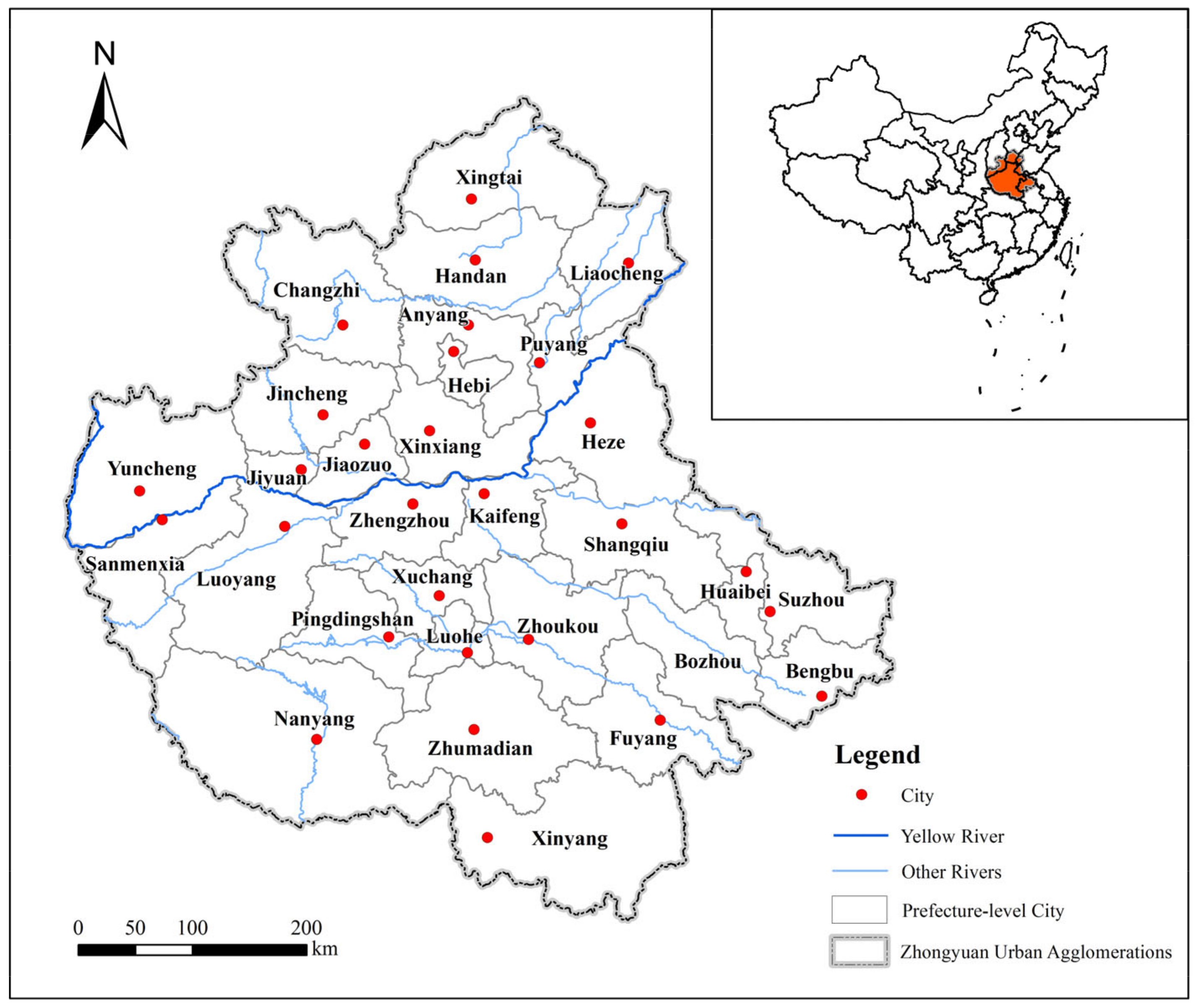
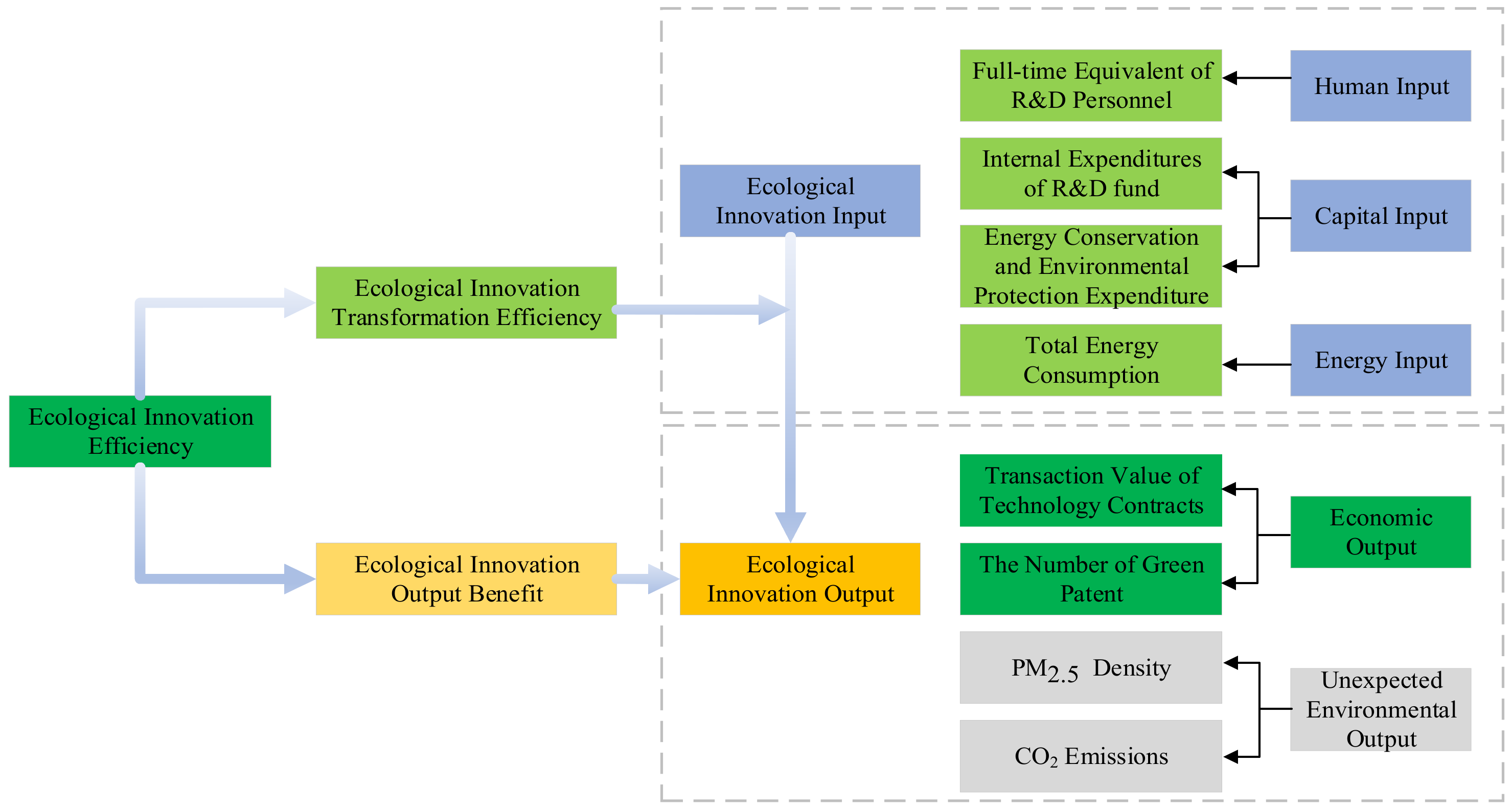
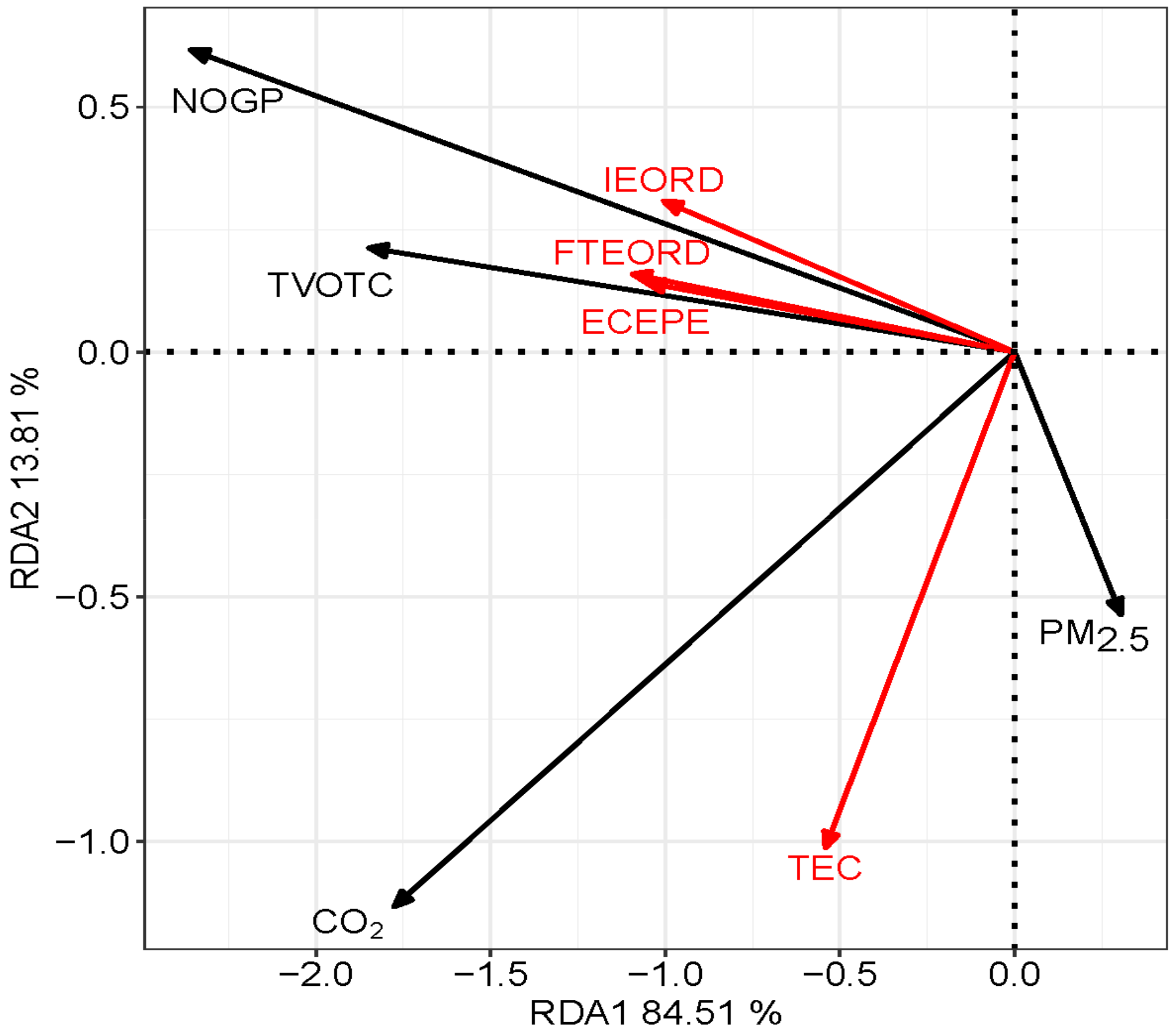
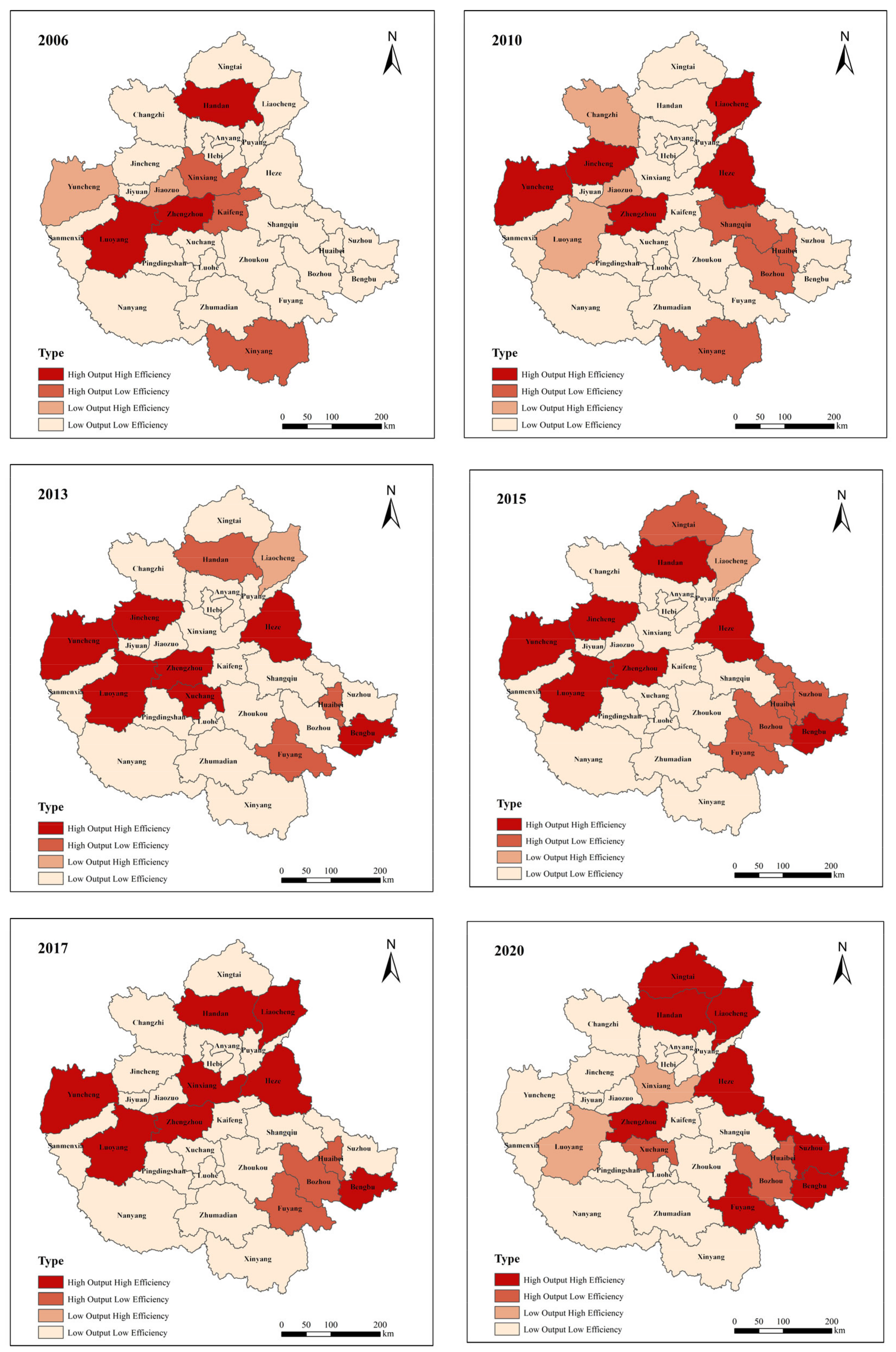
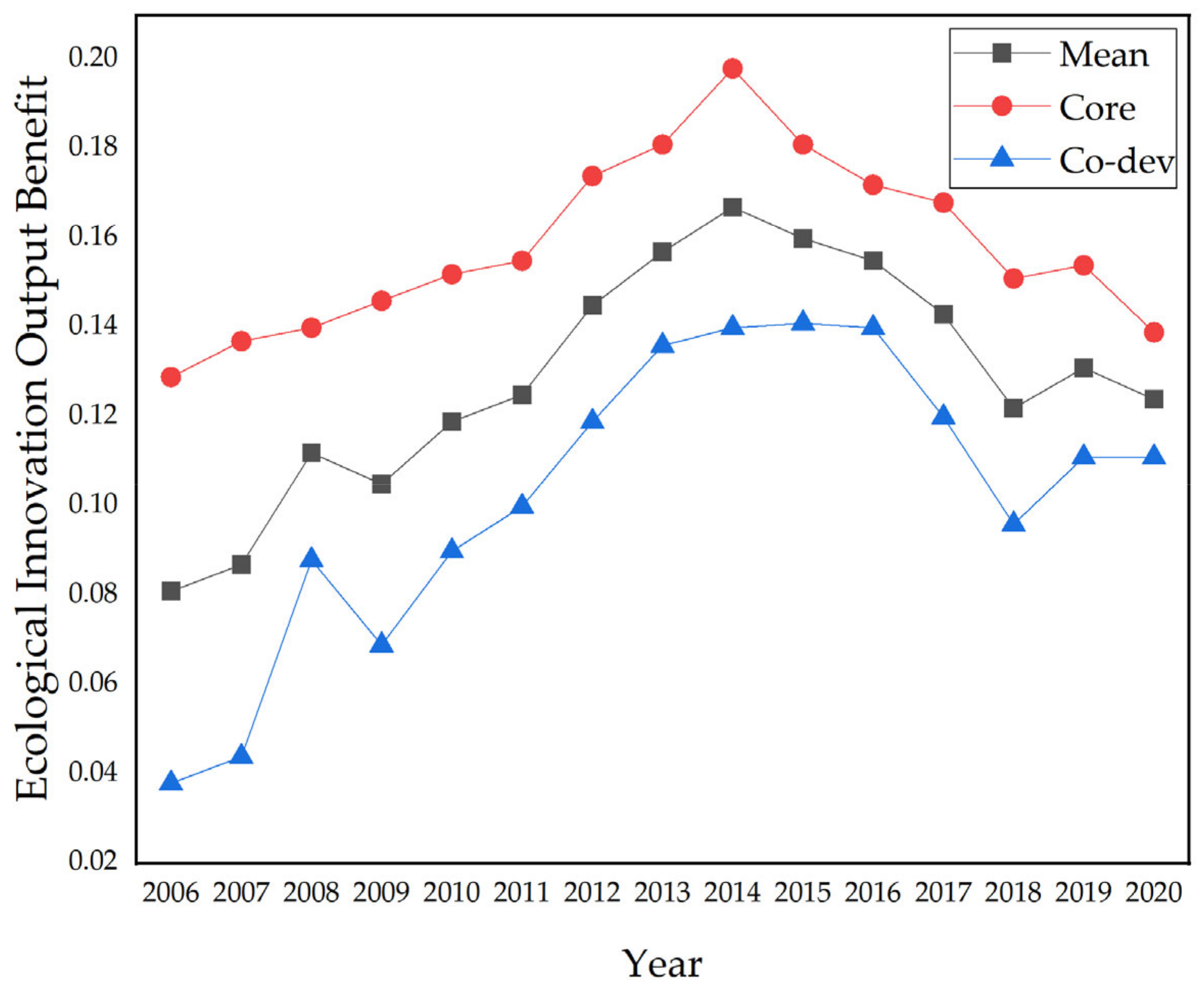


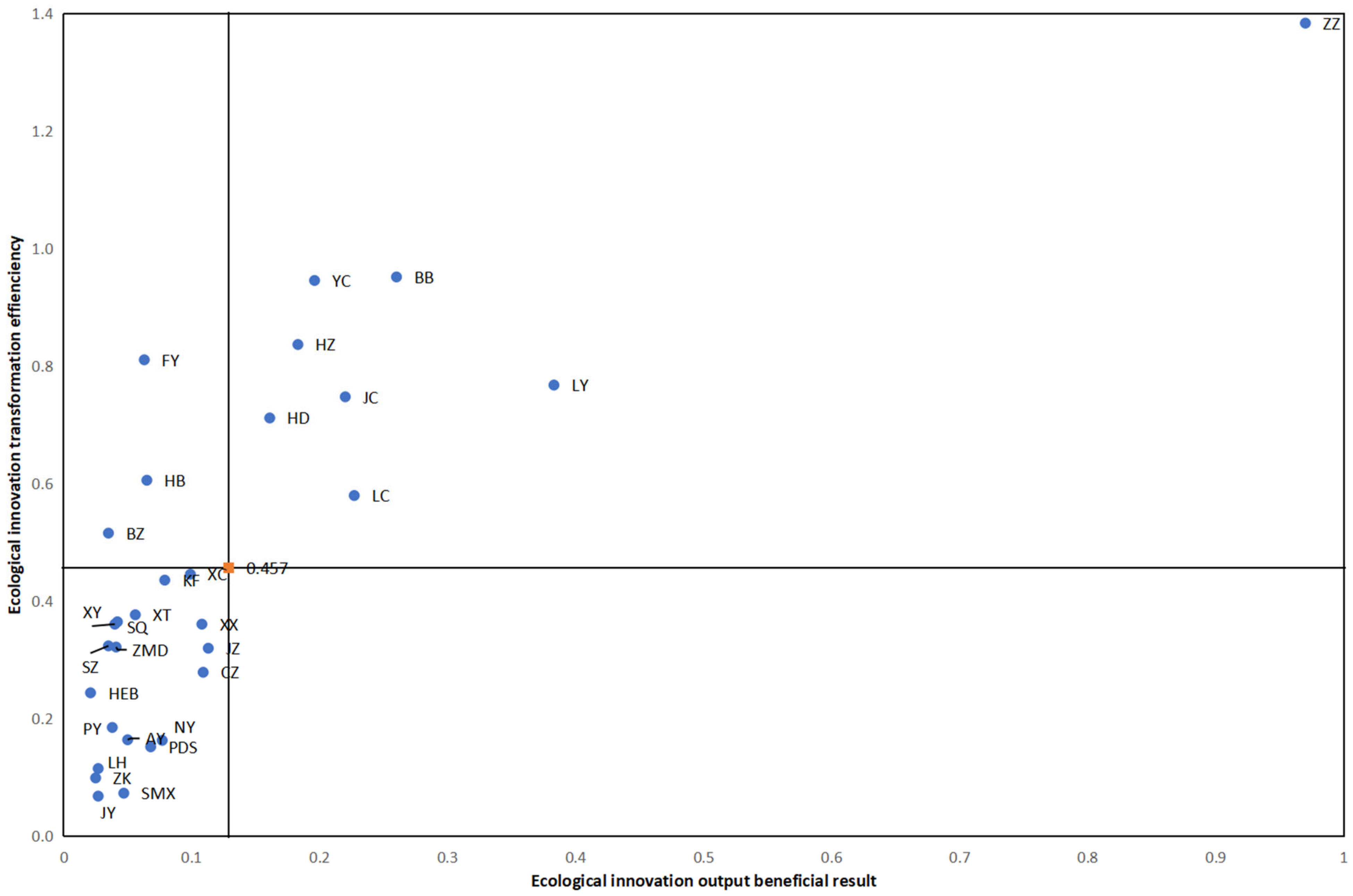
| First-Level Indicator | Index Classification | Second-Level Indicator | Source of Indicators | |
|---|---|---|---|---|
| Ecological Innovation Efficiency | Ecological Innovation Input | Human Input | Full-time Equivalent of R&D Personnel | [20,25] |
| Capital Investment | Internal Expenditures on R&D fund | [20,25] | ||
| Energy Conservation and Environment Protection Expenditure | [17] | |||
| Energy Input | Total Energy Consumption | [17,32] | ||
| Ecological Innovation Output | Economic Output | Transaction Value of Technology Contracts | Henan statistical yearbook | |
| Number of Green Patents | [33,34] | |||
| Undesirable Output | PM2.5 Density CO2 Emissions | [20,35,36] |
| Indicator | Units | Sample Size | Mean | Standard Deviation | Maximum | Minimum |
|---|---|---|---|---|---|---|
| Full-time Equivalent of R&D Personnel | Person-year | 450 | 5981.881 | 7920.835 | 74,978.200 | 219.000 |
| Internal Expenditures on R&D fund | 10,000 yuan | 450 | 208,786.535 | 300,760.600 | 2,766,726.148 | 1529.000 |
| Energy Conservation and Environment Protection Expenditure | 100 million yuan | 450 | 8.512 | 13.589 | 177.480 | 0.193 |
| Total Energy Consumption | 10,000 tons of SCE | 450 | 1015.575 | 713.594 | 3595.600 | 22.190 |
| Transaction Value of Technology Contracts | 10,000 yuan | 450 | 59,398.845 | 162,662.737 | 2,128,225.000 | 0.000 |
| The Number of Green Patents | item | 450 | 143.051 | 313.163 | 3695.000 | 1.000 |
| PM2.5 Density | μg/m3 | 450 | 64.839 | 13.785 | 108.526 | 31.547 |
| CO2 Emissions | ton | 450 | 29.595 | 15.659 | 82.353 | 5.838 |
| Year | 2006 | 2007 | 2008 | 2009 | 2010 | |||||
|---|---|---|---|---|---|---|---|---|---|---|
| City | IOB | ITE | IOB | ITE | IOB | ITE | IOB | ITE | IOB | ITE |
| ZZ | 0.990 | 1.520 | 0.987 | 1.604 | 0.977 | 1.543 | 0.979 | 1.447 | 0.982 | 1.473 |
| KF | 0.075 | 1.230 | 0.073 | 1.147 | 0.063 | 1.068 | 0.051 | 0.252 | 0.092 | 0.402 |
| LY | 0.256 | 0.505 | 0.397 | 0.475 | 0.274 | 0.308 | 0.346 | 0.399 | 0.306 | 0.346 |
| PDS | 0.046 | 0.074 | 0.036 | 0.102 | 0.053 | 0.049 | 0.052 | 0.082 | 0.071 | 0.074 |
| AY | 0.057 | 0.334 | 0.024 | 0.066 | 0.064 | 0.512 | 0.053 | 0.374 | 0.045 | 0.146 |
| HEB | 0.013 | 0.165 | 0.011 | 0.226 | 0.024 | 0.000 | 0.016 | 0.303 | 0.016 | 0.038 |
| XX | 0.074 | 1.029 | 0.059 | 0.115 | 0.102 | 0.038 | 0.068 | 0.058 | 0.076 | 0.073 |
| JZ | 0.099 | 0.246 | 0.102 | 0.241 | 0.114 | 0.328 | 0.127 | 0.340 | 0.147 | 0.391 |
| PY | 0.018 | 0.010 | 0.020 | 0.053 | 0.055 | 1.022 | 0.049 | 1.024 | 0.042 | 0.108 |
| XC | 0.012 | 0.005 | 0.030 | 0.036 | 0.059 | 0.103 | 0.090 | 0.271 | 0.056 | 0.150 |
| LH | 0.020 | 0.211 | 0.023 | 0.240 | 0.031 | 0.132 | 0.031 | 0.176 | 0.030 | 0.171 |
| SMX | 0.014 | 0.021 | 0.024 | 0.122 | 0.039 | 0.098 | 0.040 | 0.090 | 0.042 | 0.069 |
| NY | 0.054 | 0.186 | 0.041 | 0.129 | 0.072 | 0.139 | 0.072 | 0.173 | 0.057 | 0.121 |
| SQ | 0.074 | 0.493 | 0.033 | 1.081 | 0.042 | 1.099 | 0.036 | 1.108 | 0.038 | 1.027 |
| XY | 0.020 | 0.371 | 0.039 | 1.141 | 0.034 | 1.127 | 0.029 | 1.109 | 0.035 | 0.537 |
| ZK | 0.015 | 0.046 | 0.017 | 0.089 | 0.025 | 0.000 | 0.020 | 0.114 | 0.016 | 0.102 |
| ZMD | 0.031 | 1.214 | 0.033 | 0.195 | 0.029 | 0.250 | 0.024 | 0.182 | 0.030 | 0.272 |
| JY | 0.015 | 0.089 | 0.020 | 0.117 | 0.022 | 0.027 | 0.018 | 0.045 | 0.017 | 0.046 |
| JC | 0.111 | 0.106 | 0.117 | 0.160 | 0.148 | 0.176 | 0.189 | 1.120 | 0.252 | 1.111 |
| YC | 0.095 | 0.102 | 0.097 | 0.078 | 0.126 | 1.050 | 0.163 | 1.050 | 0.215 | 1.301 |
| CZ | 0.042 | 0.044 | 0.057 | 0.121 | 0.091 | 0.083 | 0.132 | 0.325 | 0.134 | 0.249 |
| HD | 0.092 | 1.003 | 0.091 | 0.378 | 0.265 | 1.053 | 0.046 | 0.142 | 0.058 | 0.149 |
| XT | 0.019 | 0.076 | 0.023 | 0.217 | 0.029 | 0.028 | 0.022 | 0.014 | 0.018 | 0.028 |
| HZ | 0.045 | 0.472 | 0.066 | 1.227 | 0.158 | 1.079 | 0.179 | 0.712 | 0.282 | 1.111 |
| LC | 0.060 | 0.290 | 0.092 | 0.289 | 0.194 | 0.295 | 0.220 | 0.381 | 0.345 | 1.003 |
| FY | 0.012 | 0.014 | 0.014 | 0.014 | 0.047 | 0.242 | 0.021 | 1.068 | 0.023 | 0.093 |
| HB | 0.017 | 0.084 | 0.019 | 0.140 | 0.024 | 0.018 | 0.018 | 0.074 | 0.036 | 1.008 |
| SZ | 0.015 | 0.060 | 0.024 | 1.154 | 0.020 | 0.076 | 0.014 | 0.303 | 0.018 | 0.000 |
| BB | 0.018 | 0.078 | 0.036 | 1.021 | 0.164 | 1.133 | 0.027 | 0.057 | 0.064 | 0.315 |
| BZ | 0.012 | 0.029 | 0.012 | 0.044 | 0.024 | 1.096 | 0.015 | 0.247 | 0.022 | 1.076 |
| Mean of Urban Agglomeration | 0.081 | 0.337 | 0.087 | 0.401 | 0.112 | 0.472 | 0.105 | 0.435 | 0.119 | 0.433 |
| Mean of Core Development Region | 0.129 | 0.325 | 0.137 | 0.313 | 0.140 | 0.340 | 0.146 | 0.347 | 0.152 | 0.385 |
| Mean of Co-development Region | 0.038 | 0.278 | 0.044 | 0.414 | 0.088 | 0.538 | 0.069 | 0.460 | 0.090 | 0.426 |
| Year | 2011 | 2012 | 2013 | 2014 | 2015 | |||||
|---|---|---|---|---|---|---|---|---|---|---|
| City | IOB | ITE | IOB | ITE | IOB | ITE | IOB | ITE | IOB | ITE |
| ZZ | 0.979 | 1.408 | 0.971 | 1.220 | 0.980 | 1.196 | 0.983 | 1.255 | 0.955 | 1.158 |
| KF | 0.048 | 0.321 | 0.031 | 0.041 | 0.036 | 0.072 | 0.487 | 1.082 | 0.038 | 0.062 |
| LY | 0.283 | 0.463 | 0.455 | 0.624 | 0.475 | 1.048 | 0.268 | 1.071 | 0.685 | 1.212 |
| PDS | 0.068 | 0.240 | 0.104 | 0.214 | 0.085 | 0.169 | 0.131 | 0.275 | 0.072 | 0.161 |
| AY | 0.050 | 0.159 | 0.049 | 0.029 | 0.054 | 0.045 | 0.052 | 0.026 | 0.041 | 0.012 |
| HEB | 0.021 | 0.000 | 0.021 | 1.017 | 0.024 | 0.141 | 0.026 | 1.021 | 0.024 | 0.048 |
| XX | 0.072 | 0.031 | 0.071 | 0.030 | 0.077 | 0.106 | 0.140 | 0.200 | 0.148 | 0.345 |
| JZ | 0.180 | 0.484 | 0.140 | 0.373 | 0.088 | 0.182 | 0.099 | 0.068 | 0.077 | 0.088 |
| PY | 0.044 | 0.149 | 0.046 | 0.081 | 0.048 | 0.013 | 0.045 | 0.003 | 0.038 | 0.008 |
| XC | 0.112 | 0.341 | 0.152 | 0.313 | 0.229 | 0.604 | 0.110 | 0.606 | 0.099 | 0.000 |
| LH | 0.045 | 0.209 | 0.026 | 0.104 | 0.027 | 0.176 | 0.020 | 0.010 | 0.021 | 0.000 |
| SMX | 0.033 | 0.000 | 0.048 | 0.082 | 0.039 | 0.000 | 0.036 | 0.005 | 0.063 | 0.163 |
| NY | 0.058 | 0.118 | 0.064 | 0.057 | 0.069 | 0.008 | 0.090 | 0.055 | 0.087 | 0.042 |
| SQ | 0.048 | 0.221 | 0.032 | 0.007 | 0.046 | 0.141 | 0.041 | 0.020 | 0.041 | 0.087 |
| XY | 0.029 | 0.002 | 0.040 | 0.165 | 0.034 | 0.166 | 0.026 | 0.123 | 0.044 | 0.000 |
| ZK | 0.020 | 0.005 | 0.027 | 0.125 | 0.024 | 0.000 | 0.019 | 0.246 | 0.029 | 0.000 |
| ZMD | 0.049 | 1.010 | 0.036 | 0.061 | 0.045 | 0.096 | 0.027 | 0.033 | 0.040 | 0.048 |
| JY | 0.018 | 0.039 | 0.023 | 0.035 | 0.023 | 0.035 | 0.021 | 0.042 | 0.040 | 0.059 |
| JC | 0.245 | 1.017 | 0.347 | 1.132 | 0.392 | 1.074 | 0.392 | 1.044 | 0.249 | 1.029 |
| YC | 0.210 | 1.178 | 0.299 | 1.564 | 0.360 | 1.139 | 0.366 | 1.155 | 0.220 | 1.017 |
| CZ | 0.119 | 0.199 | 0.210 | 0.403 | 0.133 | 0.280 | 0.102 | 0.264 | 0.131 | 0.413 |
| HD | 0.056 | 0.173 | 0.116 | 1.018 | 0.149 | 0.443 | 0.185 | 1.044 | 0.251 | 1.170 |
| XT | 0.020 | 0.025 | 0.044 | 0.079 | 0.037 | 0.127 | 0.053 | 0.184 | 0.065 | 1.018 |
| HZ | 0.218 | 1.028 | 0.177 | 0.675 | 0.216 | 0.412 | 0.220 | 0.337 | 0.244 | 0.554 |
| LC | 0.263 | 0.483 | 0.189 | 0.245 | 0.245 | 0.339 | 0.256 | 0.343 | 0.219 | 0.348 |
| FY | 0.056 | 1.116 | 0.058 | 1.061 | 0.084 | 1.142 | 0.054 | 0.437 | 0.083 | 1.069 |
| HB | 0.039 | 0.251 | 0.080 | 1.132 | 0.142 | 1.161 | 0.187 | 1.056 | 0.113 | 0.778 |
| SZ | 0.025 | 0.040 | 0.032 | 0.136 | 0.042 | 0.405 | 0.027 | 0.158 | 0.048 | 1.004 |
| BB | 0.326 | 1.208 | 0.416 | 1.298 | 0.484 | 1.194 | 0.516 | 1.252 | 0.571 | 1.229 |
| BZ | 0.028 | 0.252 | 0.037 | 0.395 | 0.032 | 0.282 | 0.039 | 1.093 | 0.051 | 1.065 |
| Mean of Urban Agglomeration | 0.125 | 0.406 | 0.145 | 0.457 | 0.157 | 0.407 | 0.167 | 0.484 | 0.160 | 0.473 |
| Mean of Core Development Region | 0.155 | 0.279 | 0.174 | 0.339 | 0.181 | 0.310 | 0.198 | 0.521 | 0.181 | 0.320 |
| Mean of Co-development Region | 0.100 | 0.468 | 0.119 | 0.535 | 0.136 | 0.464 | 0.140 | 0.428 | 0.141 | 0.589 |
| Year | 2016 | 2017 | 2018 | 2019 | 2020 | Mean | ||||||
|---|---|---|---|---|---|---|---|---|---|---|---|---|
| City | IOB | ITE | IOB | ITE | IOB | ITE | IOB | ITE | IOB | ITE | IOB | ITE |
| ZZ | 0.963 | 1.203 | 0.964 | 1.229 | 0.943 | 1.458 | 0.950 | 1.496 | 0.950 | 1.557 | 0.970 | 1.384 |
| KF | 0.062 | 0.241 | 0.038 | 0.112 | 0.030 | 0.207 | 0.029 | 0.168 | 0.034 | 0.127 | 0.079 | 0.436 |
| LY | 0.575 | 1.087 | 0.513 | 1.224 | 0.381 | 1.325 | 0.314 | 1.037 | 0.213 | 0.399 | 0.383 | 0.768 |
| PDS | 0.062 | 0.105 | 0.063 | 0.148 | 0.053 | 0.093 | 0.065 | 0.297 | 0.057 | 0.197 | 0.068 | 0.152 |
| AY | 0.063 | 0.194 | 0.046 | 0.002 | 0.040 | 0.252 | 0.059 | 0.208 | 0.050 | 0.100 | 0.050 | 0.164 |
| HEB | 0.024 | 0.256 | 0.022 | 0.082 | 0.024 | 0.095 | 0.025 | 0.147 | 0.024 | 0.115 | 0.021 | 0.244 |
| XX | 0.124 | 0.201 | 0.151 | 0.728 | 0.142 | 1.050 | 0.168 | 1.003 | 0.153 | 0.410 | 0.108 | 0.361 |
| JZ | 0.091 | 0.046 | 0.099 | 0.435 | 0.128 | 0.626 | 0.120 | 0.650 | 0.078 | 0.305 | 0.113 | 0.320 |
| PY | 0.033 | 0.012 | 0.039 | 0.012 | 0.025 | 0.006 | 0.026 | 0.095 | 0.036 | 0.185 | 0.038 | 0.185 |
| XC | 0.110 | 0.000 | 0.133 | 1.106 | 0.100 | 1.084 | 0.109 | 1.073 | 0.090 | 1.000 | 0.099 | 0.446 |
| LH | 0.028 | 0.000 | 0.027 | 0.000 | 0.020 | 0.123 | 0.026 | 0.106 | 0.027 | 0.064 | 0.027 | 0.115 |
| SMX | 0.056 | 0.085 | 0.052 | 0.134 | 0.072 | 0.062 | 0.072 | 0.086 | 0.072 | 0.072 | 0.047 | 0.073 |
| NY | 0.114 | 0.194 | 0.092 | 0.150 | 0.088 | 0.399 | 0.107 | 0.422 | 0.093 | 0.255 | 0.077 | 0.163 |
| SQ | 0.034 | 0.058 | 0.049 | 0.081 | 0.035 | 0.015 | 0.041 | 0.014 | 0.044 | 0.015 | 0.042 | 0.365 |
| XY | 0.048 | 0.000 | 0.044 | 0.180 | 0.056 | 0.216 | 0.060 | 0.152 | 0.063 | 0.130 | 0.040 | 0.361 |
| ZK | 0.029 | 0.000 | 0.033 | 0.213 | 0.029 | 0.208 | 0.034 | 0.237 | 0.035 | 0.097 | 0.025 | 0.099 |
| ZMD | 0.051 | 0.064 | 0.051 | 0.374 | 0.046 | 0.422 | 0.050 | 0.287 | 0.066 | 0.330 | 0.041 | 0.322 |
| JY | 0.036 | 0.071 | 0.032 | 0.124 | 0.038 | 0.100 | 0.040 | 0.119 | 0.044 | 0.074 | 0.027 | 0.068 |
| JC | 0.227 | 1.013 | 0.192 | 0.413 | 0.146 | 0.494 | 0.198 | 1.100 | 0.096 | 0.239 | 0.220 | 0.748 |
| YC | 0.203 | 1.050 | 0.178 | 1.049 | 0.137 | 1.083 | 0.186 | 1.085 | 0.083 | 0.291 | 0.196 | 0.946 |
| CZ | 0.101 | 0.299 | 0.089 | 0.270 | 0.080 | 0.278 | 0.126 | 0.594 | 0.093 | 0.369 | 0.109 | 0.279 |
| HD | 0.292 | 1.109 | 0.318 | 1.148 | 0.152 | 0.484 | 0.135 | 0.335 | 0.203 | 1.034 | 0.161 | 0.712 |
| XT | 0.066 | 0.217 | 0.065 | 0.306 | 0.063 | 1.017 | 0.199 | 1.274 | 0.124 | 1.044 | 0.056 | 0.377 |
| HZ | 0.234 | 1.012 | 0.168 | 0.452 | 0.210 | 1.136 | 0.156 | 1.097 | 0.173 | 1.252 | 0.183 | 0.837 |
| LC | 0.289 | 1.089 | 0.244 | 0.710 | 0.361 | 1.082 | 0.216 | 0.745 | 0.207 | 1.057 | 0.227 | 0.580 |
| FY | 0.092 | 1.142 | 0.075 | 1.089 | 0.075 | 1.535 | 0.091 | 1.057 | 0.157 | 1.089 | 0.063 | 0.811 |
| HB | 0.064 | 0.316 | 0.053 | 0.492 | 0.044 | 0.516 | 0.046 | 1.030 | 0.091 | 1.028 | 0.065 | 0.606 |
| SZ | 0.045 | 0.088 | 0.033 | 0.160 | 0.031 | 0.020 | 0.039 | 0.032 | 0.112 | 1.225 | 0.035 | 0.324 |
| BB | 0.485 | 1.535 | 0.380 | 1.173 | 0.059 | 0.394 | 0.206 | 1.222 | 0.148 | 1.172 | 0.260 | 0.952 |
| BZ | 0.048 | 0.365 | 0.036 | 0.363 | 0.038 | 0.279 | 0.040 | 0.139 | 0.094 | 1.018 | 0.035 | 0.516 |
| Mean of Urban Agglomeration | 0.155 | 0.435 | 0.143 | 0.465 | 0.122 | 0.535 | 0.131 | 0.577 | 0.124 | 0.542 | 0.129 | 0.457 |
| Mean of Core Development Region | 0.172 | 0.265 | 0.168 | 0.387 | 0.151 | 0.438 | 0.154 | 0.468 | 0.139 | 0.312 | 0.158 | 0.430 |
| Mean of Co-development Region | 0.140 | 0.547 | 0.120 | 0.503 | 0.096 | 0.567 | 0.111 | 0.620 | 0.111 | 0.692 | 0.103 | 0.481 |
Disclaimer/Publisher’s Note: The statements, opinions and data contained in all publications are solely those of the individual author(s) and contributor(s) and not of MDPI and/or the editor(s). MDPI and/or the editor(s) disclaim responsibility for any injury to people or property resulting from any ideas, methods, instructions or products referred to in the content. |
© 2023 by the authors. Licensee MDPI, Basel, Switzerland. This article is an open access article distributed under the terms and conditions of the Creative Commons Attribution (CC BY) license (https://creativecommons.org/licenses/by/4.0/).
Share and Cite
Yang, Y.; Li, S.; Su, Z.; Fu, H.; Wang, W.; Wang, Y. Research on the Ecological Innovation Efficiency of the Zhongyuan Urban Agglomeration: Measurement, Evaluation and Optimization. Sustainability 2023, 15, 14236. https://doi.org/10.3390/su151914236
Yang Y, Li S, Su Z, Fu H, Wang W, Wang Y. Research on the Ecological Innovation Efficiency of the Zhongyuan Urban Agglomeration: Measurement, Evaluation and Optimization. Sustainability. 2023; 15(19):14236. https://doi.org/10.3390/su151914236
Chicago/Turabian StyleYang, Yang, Simo Li, Zhaoxian Su, Hao Fu, Wenbin Wang, and Yun Wang. 2023. "Research on the Ecological Innovation Efficiency of the Zhongyuan Urban Agglomeration: Measurement, Evaluation and Optimization" Sustainability 15, no. 19: 14236. https://doi.org/10.3390/su151914236
APA StyleYang, Y., Li, S., Su, Z., Fu, H., Wang, W., & Wang, Y. (2023). Research on the Ecological Innovation Efficiency of the Zhongyuan Urban Agglomeration: Measurement, Evaluation and Optimization. Sustainability, 15(19), 14236. https://doi.org/10.3390/su151914236






